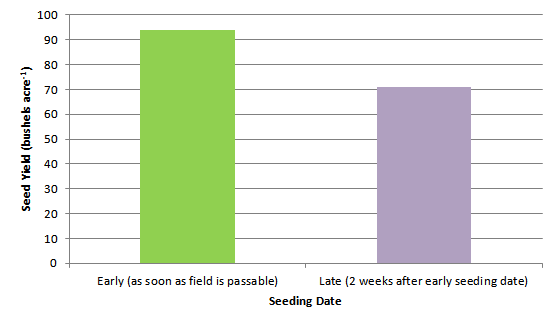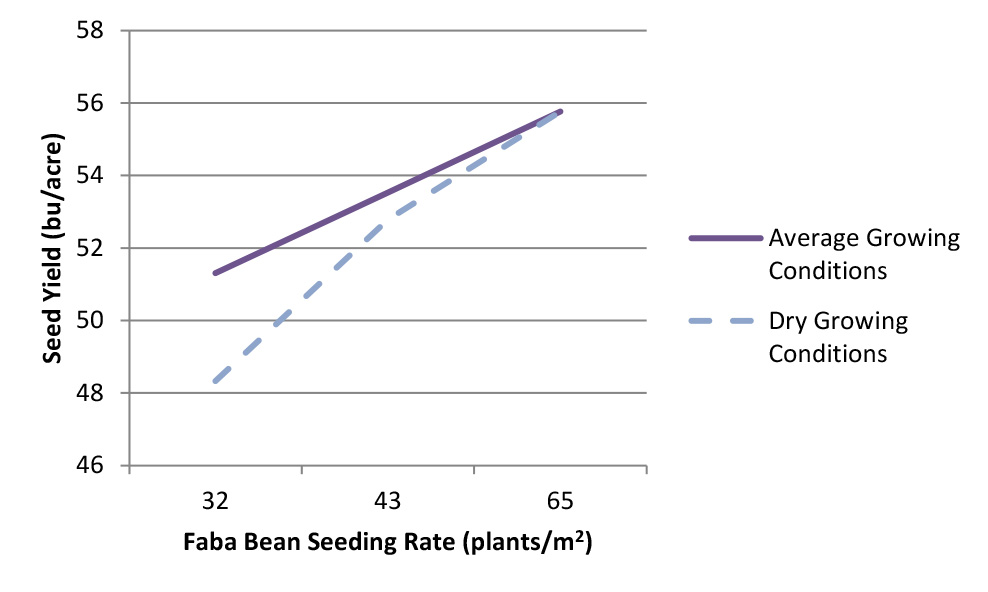| | Cultivar selection | Planting dates | Seeding rates | Seeding equipment
Faba bean production in Alberta has been increasing due to new marketing opportunities, the availability of new varieties and the need for new pulse crops in rotations.
Recent small plot research trials, conducted in south and central Alberta, have reported faba bean yields up to 10,575 kg ha-1 (157 bu acre-1). Although small plot yields are often higher than what producers can achieve on a field scale, it is a good indication that faba beans can be a high yielding, profitable crop.
Seeding faba beans early as possible and at the correct seeding rate are critical steps in producing high yields that mature in Alberta’s relatively short growing season.
Cultivar Selection
Alberta researchers recently tested new faba bean cultivars from European and Canadian breeding programs. The cultivars tested include FB 18-20, Malik (FB 9-4), Imposa and Snowbird (as a check cultivar). Traits of these cultivars are listed in Table 1 below.
FB 18-20 and Malik have white flowers with a black dot and tannin-containing seed coats (seed coats are
brown – see Figure 1). These cultivars were bred by the Crop Diversification Centre in Saskatoon, Saskatchewan, and are available for contract production.
Table 1. Traits of four faba bean cultivars grown at five Alberta locations over two growing seasons
| Cultivar | Height (cm) | Seed Weight
(g 1000 seeds-1) | Yield
(kg ha-1) | Yield
(bu acre-1) |
| FB 18-20 | 108 | 735 | 8100 | 120 |
| Malik | 109 | 719 | 8121 | 121 |
| Imposa | 113 | 601 | 7080 | 105 |
| Snowbird | 113 | 506 | 8151 | 121 |
Figure 1. Tannin-containing faba bean cultivars have white flowers with a black dot and brown seed coats.
Due to tannins in the seed coat of these cultivars, they are not suitable as monogastric livestock feed. Monogastric animals include pigs, horses, rabbits, cats and dogs.
Imposa and Snowbird have white flowers and seed coats that do not contain tannins (seed coats are white – see Figure 2). These cultivars were bred in Lelystad, The Netherlands. Imposa was granted Plant Breeder’s Rights status in 2011 and Snowbird in 2003.
Figure 2. Tannin-free faba bean cultivars have white flowers and lighter coloured seed coats.
Information about other faba bean cultivars can be found in Alberta Agriculture and Rural Development’s factsheet Varieties of Pulse Crops for Alberta, Agdex 142/32-1.
Planting Dates
Faba beans require a long growing season. Many studies have shown that delayed seeding increases the risk of drought stress, late maturity and reduced yield. Reduced yields associated with late seeding can be attributed to the crop experiencing high temperatures at the time of flower and pod set. Late seeding also reduces the vegetative growth and pod filling stages, which translate into smaller plants that cannot support high yields.
Effect on maturity
Early seeding is particularly important in years with early fall frosts that can reduce yield and quality. Alberta research has shown that if seeding is completed by the first week of May, the crop usually has 85 to 95 per cent black pods by the second week of September. A faba bean crop that has 90 per cent black pods is considered to be physiologically mature and ready for desiccation. By this point, most of the stems have turned black, the seed has 30 per cent moisture content and the crop is close to harvest.
When seeding is delayed until mid to late May, the crop is much less mature, with less than 45 per cent black pods, by the second week of September. When a faba bean plant has less than 45 per cent black pods, over half the seed is rubbery with a high moisture content. By mid to late September, days are shorter and cooler resulting in slower maturation and harvest difficulties for late seeded faba bean crops.
Effect on yield
Research conducted in north central Alberta consistently found the highest faba bean yields are achieved with
early seeding. Averaged over two locations, three growing seasons and five cultivars, early seeding
resulted in faba bean yields of 94 bushels acre-1. Seeding two weeks later consistently produced much lower yields (71 bushels acre-1).
Based on this Alberta study, faba bean yields are 32 per cent higher when the crop is seeded as early as possible, compared with seeding two weeks later (Figure 3).

Figure 3. Comparison of early versus late seeding.
Seeding Rates
Effect on maturity
Research conducted in north central Alberta found that higher seeding rates can enhance maturity when the crop is seeded late (May 27). For example, a seeding rate of 32 plants m-2 had 65 per cent black pods by the second week of September. However, when the seeding rate increased to 65 plants/m2, the crop had 75 per cent black pods by the second week of September.
Figure 4. Faba bean seeded to achieve a target stand of 43 plants m-2 (top) and 65 plants m-2 (bottom).
Ideally, faba beans should have 90 per cent black pods by the second week of September, which can usually be achieved with early seeding. In years when late seeding occurs, higher seeding rates can help enhance maturity, but this approach is still not as effective as early seeding.
Effect on yield
Alberta research studied the effects of increasing faba bean seeding rates from 32 to 65 plants m-2. Under average growing conditions, yields increased by 4 bu acre-1 (9%) as seeding rates increased. Under dry growing conditions (only 25 to 50% of the 30-year average growing season precipitation was received), yields increased by 7 bu acre-1 (15%) as seeding rates increased. It is a good risk management strategy to use higher seeding rates when dry growing conditions are anticipated.

Figure 5. Growing condition effects on yield.
It is recommended that faba bean is seeded at 43 plants m-2 or 4 plants ft-2; however, higher seeding rates may be beneficial under dry growing conditions.
Since faba bean cultivars have extremely different seed sizes, seeding rates must be based on the thousand seed weight (g 1000 seeds-1) of the seed that will be planted.
For example, the recommended seeding rate for a cultivar with a 700 g 1000 seeds-1 seed weight would be 332 lbs acre-1 (5.5 bu acre-1), while the recommended seeding rate for a cultivar with a 500 g 1000-1 seed weight would be 237 lbs acre-1 (4 bu acre-11).
Seeding Equipment
Due to the large seed size, faba bean seed often plugs at multiple points in seeding equipment. It is necessary to check for blockages and plugs frequently at the following locations:
- seed tanks for bridging
- metering devices for seed clearance (coarse metering fluted roller required)
- outlet holes on distributor mainfolds
- points where hoses bend
- seeding boot openings, especially if they are narrow or change shape drastically
Checking and clearing seed blockages frequently is critical when seeding faba bean crops. Growers are also advised to slow their seeding speed to prevent plugging.
Summary
Faba bean can be a high yielding and profitable crop for Alberta growers, with yields up to 157 bu acre-1 being reported in small plot trials. New European and Canadian cultivars are good options for growers.
Faba bean should be seeded as early as possible to achieve high yields and timely maturity. Early seeding has been found to increase yields by 32 per cent. If seeding is delayed, reduced yields will occur, and the crop will not mature resulting in harvest difficulties. The goal is to have faba bean crops reach the 90 per cent black pod stage by the second week of September.
The recommended seeding rate for faba bean is 43 plants m-2. However, seeding rates can be increased to 65 plants m-2 as a risk management tool as higher seeding rates can hasten maturity on late seeded faba bean crops and increase yields under dry conditions.
Prepared by
Sheri Strydhorst, PhD
Research Scientist, Agronomy
Alberta Agriculture and Rural Development
Mark Olson
Unit Head - Pulse Crops
Alberta Agriculture and Rural Development
More information
Contact Alberta Ag-Info Centre
Call toll free 310-FARM (3276)
Source: Agdex 142/22-1. June 2013. |
|